Ramshorn Snails are common freshwater aquarium snails. Some hobbyists choose to keep them as pets. Some hobbyists consider them to be pests. As pets, they can help in keeping the aquarium clean. As pests, they create a breeding problem in the tank.
They are a common sight in aquariums around the world and are quite fun to watch! With a detailed guide, you can take care of these snails without turning them into pests.
This guide will show you everything you need to know about Ramshorn Snails and how to take care of them.
| Information Chart | Ramshorn Snail |
| Scientific Name: | Helisoma (Planorbella) trivolvis (Say) |
| Family: | Planorbidae |
| Care Level: | Easy |
| Temperament: | Calm |
| Color: | Red, Brown, Olive-yellow, etc |
| Lifespan: | 1-3 years |
| Size: | Up to an Inch |
| Diet: | Omnivore |
| Minimum Tank Size: | 10-20 gallons |
| Temperature: | 75-80 degrees Fahrenheit |
| WaterConditions: | pH: 7.0 – 7.5, with water on the hard side |
| Tank Mate Compatibility | Should be kept with other peaceful creatures |
Table of Contents
Ramshorn Snail Appearance
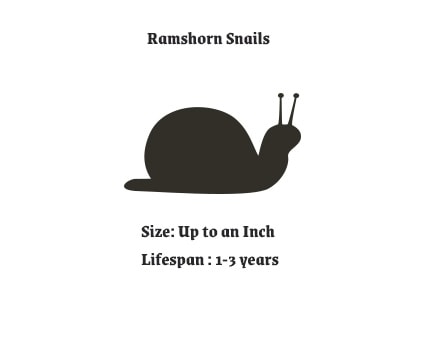
There are a lot of varieties when it comes to Ramshorn Snails. Both the shell and the skin come in various colors. This opens a world of possible color combinations.
The skin of the snail can be black or red. The black snails have melanin pigment and the red snails don’t. The red snails have a vibrant color because of their blood. Unlike other creatures, the Ramshorn Snail has blood with red hemoglobins.
The snails get their name because of the distinct shape of their shells. It features a flat spiral, which replicates the rope’s spiral or a ram’s shorn.
The color of their shells can vary widely. The most common hues that you will see are shades of light or dark brown. More unique specimens can have red shells, blue shells, and even spotted shells. The coolest fact about these snails is that their shells grow bigger as the snails grow in size over time.
As juveniles, their shells are transparent and thin. With a healthy diet, the shells harden up and become opaque as the snails grow bigger.
The spiral on the shells also becomes bigger as they grow. The shells spiral to the side and in the center, there is a hole. You might even see some skin poking out of this hole.
Unlike most snails, Ramshorn Snails don’t have an operculum even though they live underwater. The reason behind this is that they actually breathe air. They rely on oxygen to survive. The operculum blocks the air out during a drought. Hence, having an operculum would be impractical for Ramshorn Snails.
Types/Varieties of Ramshorn Snails
The most common species are Planorbella duryi, the Red Ramshorn, and Planorbarius corneus. The larger species are the Great Ramshorn. The Great Ramshorns range from olive-yellow to brown. They come with stripes on their shells.
The lifespan of Ramshorn Snails
The typical lifespan of Ramshorn Snail is One Year. Many snails can live longer. Aquarists have seen them live on for three years with optimal water conditions. However, it’s not uncommon for some snails to die when they’re added into the tank. Death might occur due to stress during transportation. This might happen due to the sudden shift in water parameters from the display tank to the home tank. Hence, a situation of sudden death is possible and should be avoided.
A dead Ramshorn Snail will lie motionless on the bottom of the tank. If Snails lie motionless for a long period, it means that they’re dead. After some time, their bodies will begin to decay. Many hobbyists keep the shells in the aquarium because they can provide additional minerals during the decomposition period.
Ramshorn Snail Size
The typical Ramshorn Snail typically grows up to one inch in diameter. These critters aren’t very big. They are only slightly larger than a dime!
The snails can be differentiated on the basis of their shells. The larger and thicker the shell, the older the snail is.
Natural Habitat and Origin
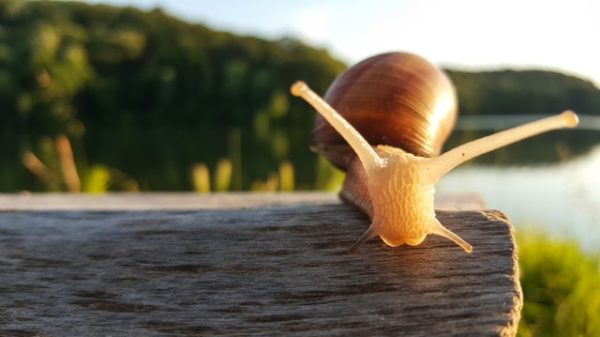
In a natural history context, the snails are aquatic pulmonate gastropod mollusks. They come from the Planorbidae family.
The Ramshorn Snails is a species that is native to North America. Its habitat ranges from Canada, Alaska, and Florida. These species have also been discovered in parts of Mexico, Peru, and Ecuador. The Ramshorn Snails can be found at the bottom of swamps, lakes, rivers, and ponds.
Ramshorn Snail care and tank set-up
Ramshorn Snail Tank Size and Specification
Optimum Tank Size for Ramshorn Snail
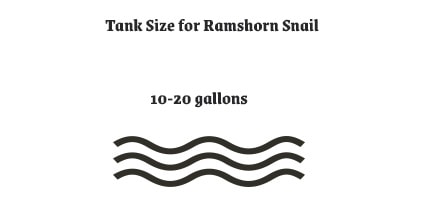
The recommended tank size for Ramshorn Snail is 10-20 gallons. 10 gallons would be great if their population is kept minimum. 20 gallons is perfect for a bigger population of snails.
The snails might be slow and steady, but they do love to roam around freely. Having more space would facilitate their natural feeding. This would be of great advantage for the aquarium.
Tank Shape for Ramshorn Snail
You do not have to worry about having a specific tank shape for their snails. These snails are low on maintenance. Hence, they manage to adapt to different tanks regardless of their shape.
Filter Type
Any typical fish filter would do just fine. However, it is important to make sure the filter guard is small. This would make sure that baby snails don’t get sucked in. This would kill the snails as well as damage the filters.
Substrate
There are a lot of options when looking for a substrate for the snails. They don’t need a particular type of substrate. Fine-grained sand is a good option. They would create a smooth surface at the bottom of the tank. This is less likely to scratch the snails and cause any harm to them.
How many Ramshorn Snails in a 10-20 gallons tank
In a 10-20 gallon tank, you could fit in 1-2 Ramshorn Snails per gallon. But, it is important to keep their population to a minimum number. This would prevent overcrowding and not mess up the filtration process.
Water Parameters for Ramshorn Snails
Water Temperature
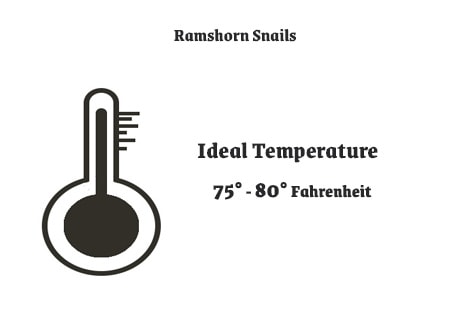
The ideal water temperature for Ramshorn Snails is 75-80 degrees Fahrenheit.
The snails prefer consistent water conditions. There should not be sudden changes in the water temperature. Good water conditions allow for the snails to be healthy and grow stronger. Water conditions also determine the strength of their shells. These snails can thrive in clear water conditions.
Water flow rate
Ramshorn snails can live in a variety of water conditions. However, they prefer very moderate flow waters. They also like to live in clear waters. There aren’t any odd conditions that you have to provide. Their environment must be consistent and should not have any sudden changes. Water flow that aligns with the freshwater standards would be best for the snails to thrive.
pH level
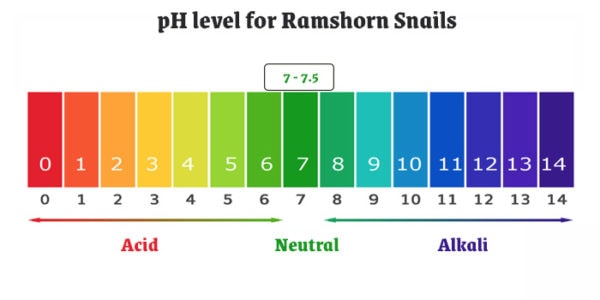
The perfect water pH level for Ramshorn Snails is 7.0 to 7.5. pH testing kits can be purchased from local pet stores. This will help in keeping the pH level in its desirable range. Occasional water checks are important to make sure that the snails are living in healthy conditions.
The snails prefer water with no chlorine as they are sensitive to it. Along with checking the pH, it is a must to keep a check on the chlorine levels in the water. They can use the de-chlorinator if the chlorine level is high. It would take 24 hours for the chlorine to evaporate from the water. Dechlorinators are available in most pet stores. However, you must make sure that they do not have any added chemicals.
Water Hardness
Water must be kept on the hard side to aid healthy snail shell growth.
They thrive in clear waters as well as in murky habitats. To maintain the consistency of their tank, it is better to come up with a schedule for a routine water check. The schedule can be worked around the needs of other creatures in the aquarium.
Even though these snails are low on maintenance, water conditions are important to make sure that they stay healthy. Keeping a check on this condition would help the snails grow into healthy creatures.
Ramshorn Snail Tank Landscape
There’s not a whole lot that you can do with the Tank to keep the snails happy. Since they do not need much attention, the tank landscape can be designed according to the needs of the other animals. You do not have to be concerned about their hiding space or create a fun landscape for them.
Best Plants for Ramshorn Snails Tank
Plants are essential for Ramshorn Snails. They can also benefit from the aquarium. The snails love to hang out on the plant leaves. There is a lot of contention among aquarium keepers about these snails because they then eat plants. However, they will only eat plants if they do not find food elsewhere.
Ramshorn Snails can adapt to a variety of habitats. They would enjoy tanks with lively plants. Live aquarium plants shed live or dead plant matter into the aquarium. This turns into food for the snails. Tanks with live plants are never too clean, and so Ramshorn Snails become a good addition to the tank. They will eat up pieces of live plants that fall off. Some Snails enjoy eating leaves of stem plants such as Cabomba and Anachairs.
Worst plant for Ramshorn Snails Tank
Any plant that can be hazardous for the overall wellbeing of the tank and its animals would be unsafe for the snails. Hence, it is always better to have plants that are compatible with all the species in the tank.
Decoration for Ramshorn Snails Tank
Any standard decorations can be used for the Tank. Decorations can be put in according to the preferences of the other aquatic animals of the tank. However, avoid sharp objects because they can cause harm to the snails. The decorations must also be compatible with the water standards of the tank and should not pollute it.
Lighting for Ramshorn Snails Tank
When it comes to lighting, normal aquarium lighting will be perfect for snails. Anything too bright may be uncomfortable for the other animals in the tank. Hence, normal tank lighting will be perfect for the snails and their tank mates.
It is important to test the tank water often. Ammonia and Nitrate problems must remain at 0 ppm. You must be careful when using plant fertilizers as some can be harmful to their snails. Most importantly, copper must be avoided at all costs, because copper, even in small doses, can be lethal. Water testing will keep the environment healthy for the snails.
Feeding Ramshorn Snails
Best Diet for Ramshorn Snails
The snails spend a lot of their time on hard surfaces looking for food to feed on. Their main source of food comes from dead or decaying plant matter, soft algae, uneaten food, and fallen tank mates. A Ramshorn Snails diet should also include a variety of fish flakes, pellets, bottom feeder tablets, algae wafers, and calcium-rich supplements. Calcium supplements will help in aiding healthy shell growth. A favorite Ramshorn Snail food is soft green algae which are found on hard surfaces like aquarium glass, filter intakes, gravel, and decorations. They may also be interested in soft brown algae that are found below the substrate. They are not interested in green spot algae. This may be due to the hardness of the algae.
Ramshorn Snails can also eat dead fish, shrimps, or snails. However, it is best to remove dead aquatic animals from the tank to avoid ammonia spikes or other water issues.
It is also great to give Ramshorn Snails fresh pieces of vegetables. Rinsed green lettuce leaves, spinach leaves, and even green zucchini slices are some good options. While it is good to drop in pieces of these vegetables into the tank, softening them before feeding is a good alternative. One must note that, knowing if the snails like vegetables will be a trial and error situation. If the snails do not eat pieces of vegetables in 24 hours, they must be removed from the tank. Too much uneaten food can ruin the water quality of the tank.
How often should you feed Ramshorn Snails?
One does not have to worry too much about their feeding time. The fact that these snails feed on debris is a big plus point. However, giving them small amounts of calcium supplements a few times a week would be beneficial for the snails. If there are no sights of debris in the tank, then it’s advisable to provide them with additional sources of food that would be necessary. As mentioned above, giving them vegetable pieces once in a while would be beneficial too.
Ramshorn Snails behavior and temperament
Are Ramshorn Snails lone or societal?
Ramshorn Snails mostly keep to themselves. They’re peaceful and do not pose any danger to other creatures in the tank. They are quite active. They will roam around the tank day and night looking for food.
Ramshorn Snails also eat in groups. They are largely nocturnal, so they will look for food once the night falls. When one Ramshorn Snail finds food, the others will move to that area to eat. The group of snails will stay in that area till the food is fully eaten.
Ramshorn Snails Tank Mates
Ideal Ramshorn Snails Tank Mates
It is recommended that Ramshorn Snails have calm tank mates. Otocinclus Catfish and Cory Catfish are excellent choices. Freshwater shrimps such as Bamboo Shrimp, Amano Shrimp, Ghost Shrimp, Red Cherry Shrimp, and Vampire Shrimp can also be tankmates. Additionally, their tank mates could include gold snails, silver snails, ivory snails, Mystery Snails, trumpet snails.
Bad Tank Mates for Ramshorn Snails
Cichlids, goldfish, and other aggressive fish should not be kept along with Ramshorn snails, as they can harm this defenseless creature. Aquarium crayfish like Hammers Cobalt Blue Lobster and Tangerine Lobster are also not good tank mates. They can capture and eat a slow Ramshorn Snail.
Breeding Ramshorn Snails
Ramshorn Snail breeding is extremely easy. They reproduce frequently without needing any outside help. They lay eggs very often because of which their population can grow dramatically.
These snails are hermaphrodites. Therefore, they possess both sexual organs. As a result, a male and female snail is not required. Unlike other snail species, they can breed quickly with each other. During the breeding season, they lay multitudes of egg clusters throughout the water. They’re often well-hidden. Occasionally, they can be found on plant stems. The clusters contain approximately 12 clear eggs. It will be apparent within a few days that there is a baby snail inside. Eventually, the tiny snails will hatch and begin looking for food as soon as they emerge from the eggs. Ramshorn Snails feed on soft algae on their own as well!
Ramshorn Snails breeding level : EASY
Sexual Dimorphism of Ramshorn Snails
Ramshorn Snails are hermaphrodites. So, we cannot distinguish between male and female snails because the snails have both sexual organs.
Common diseases and their treatment
With Ramshorn Snails the problem is not the kind of diseases they might have but the kind of diseases they can bring to the tank. These snails are very resilient. Major diseases aren’t a huge problem. However, they can bring notorious diseases into the tank.
Parasitic Skin Flukes
If they are bought in a store, they may have parasitic skin flukes. These snails are the perfect hosts for parasites. Since these parasites are difficult to see, they might go unnoticed while putting these snails into the tank. These flukes can latch onto the side of the other fish to feed. They can create a stressful environment in the tank and create health complications.
It is recommended to keep them in quarantine tanks. This will not put the larger fish community in the tank at risk. Quarantining the snails can help in reducing the problem of parasites.
Facts about Ramshorn Snails
- The daily activity of the Ramshorn Snail is quite interesting. They are most active during dawn and dusk. Their activity fluctuates during the night.
- Freshwater Snails have the unusual ability to regulate their buoyancy by adjusting the amount of air in their lungs. They use this to sink, float or rise within the water.
- Mollusks like the Ramshorn Snails have a kidney located near the heart. They use this to remove nitrogenous waste from their blood. It is then carried via the excretory duct, which runs alongside the rectum to a pore located at the mantle edge.
Are Ramshorn Snails right for you?
The usefulness of these snails is contested among hobbyists. Because of their reproducing ability, some think of them as pests. However, their ability to keep the tank clean makes them a pet for several people. On the positive side, they can help in keeping the tank environment clean by eating debris or dead materials. If their breeding is kept under control, they can turn into a useful addition to the tank.
FAQ
Since Ramshorn Snails are highly adaptable to extreme water conditions. Their extensive breeding capacity makes them an invasive species. Although they have become unnaturally assimilated into environments, their presence has become accepted as part of the ecosystem in many places.
Yes. Ramshorn Snails can reproduce asexually. A single Snail can lay a cluster of eggs that hatch into dozens of new snails.
Some aquarium species will eat Ramshorn Snails. More ravening eaters include Puffers, Loaches, Crayfish, and most Gouramis.
Conclusion
Ramshorn Snails can be a useful addition to the aquarium. Their ability to adapt and clean their environment makes them an asset to the aquarium. They are low on maintenance and don’t need much of anyone’s time. The snails can become a problem due to their breeding capacity. However, if this is kept under control they can turn into useful pets. Whether they are pets or pests is something that only the hobbyist can decide for themselves. With enough care, they can become a purchase that you won’t regret.
